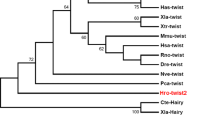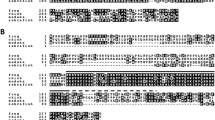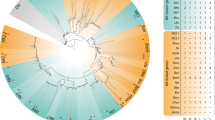Abstract
The leech Helobdella sp. (Austin) has two genes of the Pax6 subfamily, one of which is characterized in detail. Hau-Pax6A was expressed during embryonic development in a pattern similar to other bilaterian animals. RNA was detected in cellular precursors of the central nervous system (CNS) and in peripheral cells including a population associated with the developing eye. The CNS of the mature leech is a ventral nerve cord composed of segmental ganglia, and embryonic Hau-Pax6A expression was primarily localized to the N teloblast lineage that generates the majority of ganglionic neurons. Expression began when the ganglion primordia were four cells in length and was initially restricted to a single cell, ns.a, whose descendants will form the ganglion’s anterior edge. At later stages, the Hau-Pax6A expression pattern expanded to include additional CNS precursors, including some descendants of the O teloblast. Expression persisted through the early stages of ganglion morphogenesis but disappeared from the segmented body trunk at the time of neuronal differentiation. The timing and iterated pattern of Hau-Pax6A expression in the leech embryo suggests that this gene may play a role in the segmental patterning of CNS morphogenesis.






Similar content being viewed by others
References
Arendt D, Tessmar K, de Campos-Baptista MI, Dorresteijn A, Wittbrodt J (2002) Development of pigment-cup eyes in the polychaete Platynereis dumerilii and evolutionary conservation of larval eyes in Bilateria. Development 129:1143–1154
Baker MW, Macagno ER (2000) RNAi of the receptor tyrosine phosphatase HmLAR2 in a single cell of an intact leech embryo leads to growth-cone collapse. Curr Biol 10:1071–1074
Balczarek KA, Lai Z-C, Kumar S (1997) Evolution and functional diversification of the Paired Box (Pax) DNA-binding domains. Mol Biol Evol 14:829–842
Baptista CA, Gershon TR, Macagno ER (1990) Peripheral organs control central neurogenesis in the leech. Nature 346:855–858
Bely AE, Weisblat DA (2006) Lessons from leeches: a call for DNA barcoding in the lab. Evol Dev 8:491–501
Bissen ST, Weisblat DA (1987) Early differences between alternate n blast cells in leech embryo. J Neurobiol 18:251–269
Bissen ST, Weisblat DA (1989) The durations and compositions of cell cycles in embryos of the leech, Helobdella triserialis. Development 105:105–118
Blair SS (1982) Interactions between mesoderm and ectoderm in segment formation in the embryo of a glossiphoniid leech. Dev Biol 89:389–396
Blair SS, Weisblat DA (1982) Ectodermal interactions during neurogenesis in the glossiphoniid leech Helobdella triserialis. Dev Biol 91:64–72
Braun J, Stent GS (1989) Axon outgrowth along segmental nerves in the leech. I. Identi-fication of candidate guidance cells. Dev Biol 132:471–485
Callaerts P, Halder G, Gehring WJ (1997) PAX-6 in development and evolution. Annu Rev Neurosci 20:483–532
Callaerts P, Leng S, Clements J, Benassayag C, Cribbs D, Kang YY, Walldorf U, Fischbach KF, Strauss R (2001) Drosophila. Pax-6/eyeless is essential for normal adult brain structure and function. J Neurobiol 46:73–88
Collinson JM, Hill RE, West JD (2000) Different roles for Pax6 in the optic vesicle and facial epithelium mediate early morphogenesis of the murine eye. Development 127:945–956
Czerny T, Busslinger M (1995) DNA-binding and transactivation properties of Pax-6: three amino acids in the paired domain are responsible for different sequence recognition of Pax-6 and BSAP (Pax-5). Mol Cell Biol 15:2858–2871
Gott JM, Emeson RB (2000) Functions and mechanisms of RNA editing. Annu Rev Genet 34:499–531
Hartmann B, Lee PN, Kang YY, Tomarev S, de Couet HG, Callaerts P (2003) Pax6 in the sepiolid squid Euprymna scolopes: evidence for a role in eye, sensory organ and brain development. Mech Dev 120:177–183
Johnson LA, Kristan WB Jr, Jellies J, French KA (2000) Disruption of peripheral target contact influences the development of identified central dendritic branches in a leech motor neuron in vivo. J Neurobiol 43:365–378
Kammermeier L, Leemans R, Hirth F, Flister S, Wenger U, Walldorf U, Gehring WJ, Reichert H (2001) Differential expression and function of the Drosophila Pax6 genes eyeless and twin of eyeless in embryonic central nervous system development. Mech Dev 103:71–78
Kretz JR, Stent GS, Kristan WB Jr (1976) Photosensory input pathways in the medicinal leech. J Comp Physiol 106:1–37
Kristan WB Jr, Calabrese RL, Friesen WO (2005) Neuronal control of leech behavior. Prog Neurobiol 76:279–327
Lans D, Wedeen CJ, Weisblat DA (1993) Cell lineage analysis of the expression of an engrailed homolog in leech embryos. Development 117:857–871
Loosli F, Kmita-Cunisse M, Gehring WJ (1996) Isolation of a Pax-6 homolog from the ribbonworm Lineus sanguineus. Proc Natl Acad Sci USA 93:2658–2663
Macagno ER, Stewart RR (1987) Cell death during gangliogenesis in the leech: competition leading to the death of PMS neurons has both random and nonrandom components. J Neurosci 7:1911–1918
Marin-Burgin A, Eisenhart FJ, Baca SM, Kristan WB Jr, French KA (2005) Sequential development of electrical and chemical synaptic connections generates a specific behavioral circuit in the leech. J Neurosci 25:2478–2489
Nardelli-Haefliger D, Shankland M (1992) Lox2. , a putative leech segment identity gene, is expressed in the same segmental domain in different stem cell lineages. Development 116:697–710
Pineda D, Rossi L, Batistoni R, Salvetti A, Marsal M, Gremigni V, Falleni A, Gonzalez-Linares J, Deri P, Salo E (2002) The genetic network of prototypic planarian eye regeneration is Pax6 independent. Development 129:1423–1434
Ramírez F-A, Wedeen CJ, Stuart DK, Lans D, Weisblat DA (1995) Identification of a neurogenic sublineage required for CNS segmentation in an Annelid. Development 121:2091–2097
Riechmann JL, Ito T, Meyerowitz EM (1999) Non-AUG initiation of AGAMOUS mRNA translation in Arabidopsis thaliana. Mol Cell Biol 19:8502–8512
Sawyer RT (1986) Leech biology and behaviour. Clarendon, London
Seaver EC, Shankland M (2000) Leech segmental repeats develop normally in the absence of signals from either anterior or posterior segments. Dev Biol 224:339–353
Shain D, Ramirez-Weber F-A, Hsu J, Weisblat DA (1998) Gangliogenesis in leech: morphogenetic processes leading to segmentation in the central nervous system. Dev Genes Evol 208:28–36
Shain DH, Stuart DK, Huang FZ, Weisblat DA (2000) Segmentation of the central nervous system in leech. Development 127:735–744
Shankland M (1987) Differentiation of the O and P cell lines in the embryo of the leech.I. Sequential commitment of blast cell sublineages. Dev Biol 123:85–96
Shankland M, Martindale MQ (1989) Segmental specificity and lateral asymmetry in the differentiation of developmentally homologous neurons during leech embryogenesis. Dev Biol 135:431–448
Stent GS, Kristan WB Jr, Torrence SA, French KA, Weisblat DA (1992) Development of the leech nervous system. Int Rev Neurobiol 33:109–133
Stoykova A, Gotz M, Gruss P, Price J (1997) Pax6-. dependent regulation of adhesive patterning, R-cadherin expression and boundary formation in developing forebrain. Development 124:3765–3777
Stuart DK, Blair SS, Weisblat DA (1987) Cell lineage, cell death, and the developmental origin of identified serotonin- and dopamine-containing neurons in the leech. J Neurosci 7:1107–1122
Stuart DK, Torrence SA, Law MI (1989) Leech neurogenesis. I. Positional commitment of neural precursor cells. Dev Biol 136:17–39
Tomarev SI, Callaerts P, Kos L, Zinovieva R, Halder G, Gehring W, Piatigorsky J (1997) Squid Pax-6 and eye development. Proc Natl Acad Sci USA 94:2421–2426
Torrence SA, Law MI, Stuart DK (1989) Leech neurogenesis. II. Mesodermal control of neuronal patterns. Dev Biol 136:40–60
Venkitaramani DV, Wang D, Ji Y, Xu YZ, Ponguta L, Bock K, Zipser B, Jellies J, Johansen KM, Johansen J (2004) Leech filamin and tractin: markers for muscle development and nerve formation. J Neurobiol 60:369–380
Weisblat DA, Shankland M (1985) Cell lineage and segmentation in the leech. Philos Trans R Soc Lond B 312:39–56
Woodruff JB, Mitchell BJ, Shankland M (2007) Hau-Pax3/7A is an early marker of leech mesoderm involved in segmental morphogenesis, nephridial development, and body cavity formation. Dev Biol (in press), DOI 10.1016/j.ydbio.2007.03.002
Acknowledgments
This work was supported by NSF grant IBN-0415732 and funds from the University of Texas Austin Vice President of Research. The authors thank Kristina Schlegel for her artistic help with the illustrations.
Author information
Authors and Affiliations
Corresponding author
Additional information
Communicated by M.Q. Martindale
Rights and permissions
About this article
Cite this article
Quigley, I.K., Xie, X. & Shankland, M. Hau-Pax6A expression in the central nervous system of the leech embryo. Dev Genes Evol 217, 459–468 (2007). https://doi.org/10.1007/s00427-007-0156-1
Received:
Accepted:
Published:
Issue Date:
DOI: https://doi.org/10.1007/s00427-007-0156-1




